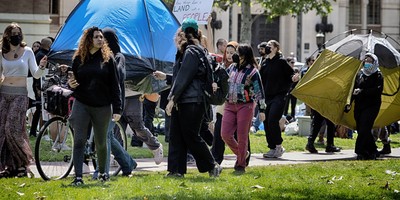Two weeks ago, I visited New York City with my wife, who was interviewing at a local medical school located in the Bronx. I dropped her at the school. Since I was lacking a car, I hopped on a public bus, intending to take it to the local subway station.
I have never been so frightened for my country in my life.
The bus itself was fine; all the people on it had places to be. It was the subway station that was truly scary. The station itself looked like a bomb had hit it. Debris covered the shattered tile floor. The stench of vomit and urine permeated the place. Rust layered the tracks; wooden boards between the tracks moldered into dust. The station had clearly been beautiful at one point, but now it looked like a leftover set from "The Omega Man."
Elderly people sat holding their cheap knockoff bags, quietly avoiding eye contact with the younger crowd. Young people gathered in small groups, speaking in broken English into their expensive cell phones. I saw a couple of young men pass small plastic bags to one another.
Then I got on the train. As the Bronx rushed past, shattered images stuck to the smeared windows like flies to a windshield: buildings with graffiti on every air conditioner, on every window, on every door; empty lots covered in garbage; apartments with hundreds of broken windows; the Bronx River, pieces of wreckage sticking at obtuse angles from the muddy water. The landscape of hopelessness.
This isn't how the Bronx used to be. Two generations ago, the Bronx was a diverse and thriving lower- to middle-class enclave, full of upwardly mobile people. The area was largely immigrant and hummed with the excitement of a population looking to take advantage of the American dream. Myriads of intellectuals grew up in the Bronx, ranging from Don DeLillo to E.L. Doctorow to Harold Bloom to David Halberstam to Chaim Potok to William Safire, entertainers like Woody Allen, Paddy Chayefsky and Stanley Kubrick, and entrepreneurs ranging from Ralph Lauren to Eli Broad to Calvin Klein.
Recommended
Then the government got involved.
Over the course of the 1960s and 1970s, in an attempt to fight poverty, the New York City government instituted higher property taxes and rent control. The idea behind the property taxes was simple redistributionism -- tenants should be given more money from the pockets of landlords. The same held true for rent control -- the unspoken idea was that landlords had been gypping their tenants.
The unintended consequences were disastrous. Poorer and poorer populations began moving to the Bronx, driving out the aspiring lower middle class. Landlords who had already been operating at profit minimums began losing money. It became simpler for them to burn down their buildings than to fix them up. Similarly, tenants began torching buildings in the hope that the government would build new public housing at the sites. The result became a national catch phrase when Howard Cosell, during the 1977 World Series, commented on an aerial shot of the city: "There it is, ladies and gentlemen: the Bronx is burning."
Today, the Bronx is barren. All the talk of urban renewal is papier-mache pomposity. Even as the elite crowd celebrates the "diversity" and "artistic regrowth" of the Bronx, the Bronx remains a crime and poverty center. In the South Bronx, nearly 50 percent of residents live below the poverty line. Rap and art nouveau will not heal an area destroyed by government interventionism and the substitution of top-down economics for bottom-up entrepreneurialism. The culture of dependency has poisoned the groundwater. The Bronx River is infected with it.
Today, when Americans look at places like Detroit and South Central Los Angeles and the Bronx, they see outliers, locations thrown by fortune or luck to the bottom of the heap. They do not see the policies that led to these areas' fall from grace. And so we continue to elect the same politicians who made the Bronx of literature and jazz into the Bronx of graffiti and hip-hop and prostitution and drugs. Politics and culture had consequences for the Bronx, and they have consequences for America more broadly.
























Join the conversation as a VIP Member